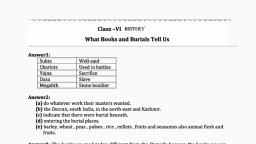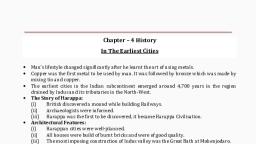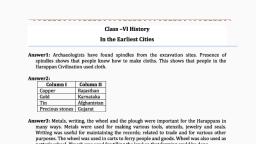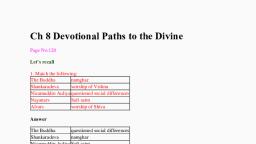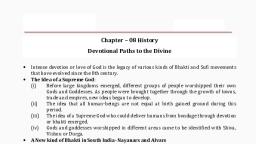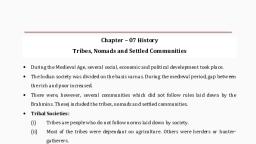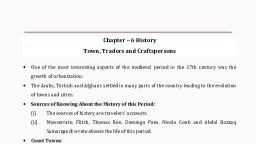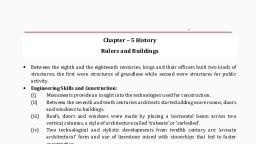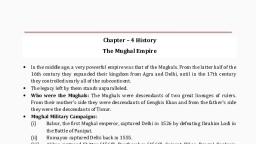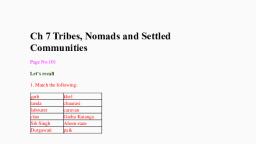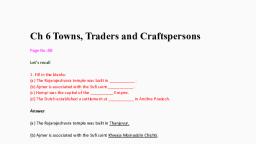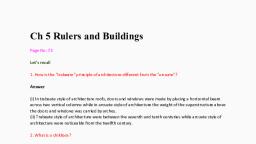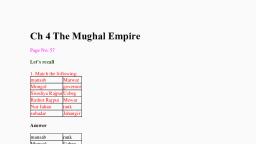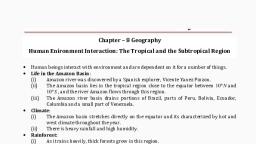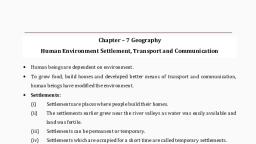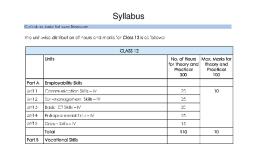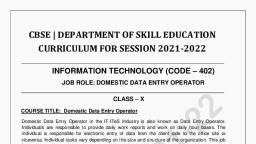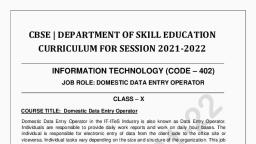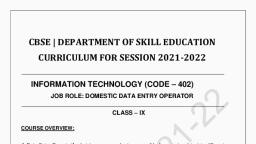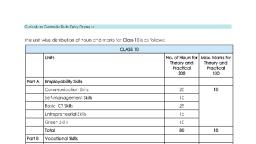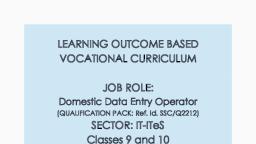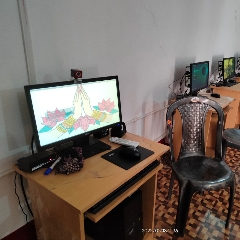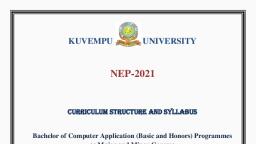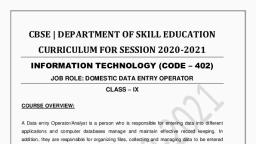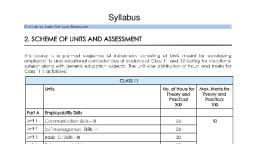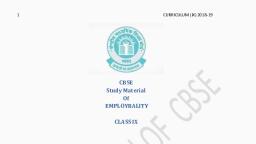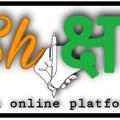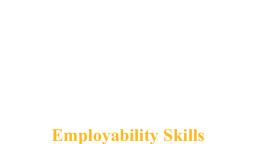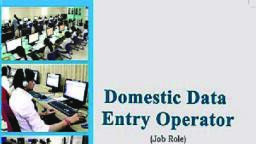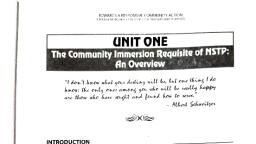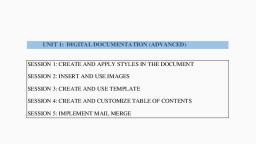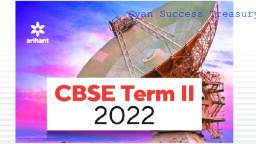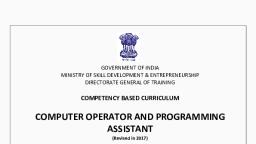Page 1 :
CBSE | DEPARTMENT OF SKILL EDUCATION, CURRICULUM FOR SESSION 2021-2022, INFORMATION TECHNOLOGY (CODE – 402), JOB ROLE: DOMESTIC DATA ENTRY OPERATOR, CLASS – X, COURSE TITLE: Domestic Data Entry Operator, Domestic Data Entry Operator in the IT-ITeS Industry is also known as Data Entry Operator., Individuals are responsible to provide daily work reports and work on daily hour bases. The, individual is responsible for electronic entry of data from the client side to the office site or, viceversa. Individual tasks vary depending on the size and structure of the organization. This job, requires the individual to have thorough knowledge of various technology trends and processes, as well as have updated knowledge about database management systems and IT initiatives. The, individual should have fast and accurate typing/data encoding. This job involves working in a, personal computer, and appropriate software to enter accurate data regarding different issues, like retrieving data from a computer or to a computer, , COURSE OUTCOME:, On completion of the course, students should be able to:, •, •, •, •, •, •, •, •, •, •, •, •, •, •, •, •, , Apply effective oral and written communication skills to interact with people and customers;, Identify the principal components of a computer system; Demonstrate the basic skills of using, computer;, Demonstrate self-management skills;, Demonstrate the ability to provide a self-analysis in context of entrepreneurial skills and, abilities;, Demonstrate the knowledge of the importance of green skills in meeting the challenges of, sustainable development and environment protection;, Work safely on computer., Start the computer., Open and use the related software., Exit from the software., Shut down the computer., Use the computer for data entry process., Collect all necessary information about the query., Log any decision about the query on the data entry tracking form., Follow Rules and guidelines for data entry., Handle queries., Undertake data entry with speed and accuracy., Identify and control hazards in the workplace that pose a danger or threat to their safety or, health, or that of others., , Page 1 of 15
Page 2 :
COURSE OBJECTIVES:, In this course, the students will be introduced to the fundamental concepts of digital, documentation, digital spreadsheet, digital presentation, database management and internet, security., The following are the main objectives of this course:, • To familiarize the students with the world of IT and IT enabled services., • To provide an in-depth training in use of data entry, internet and internet tools., • To develop practical knowledge of digital documentation, spreadsheets and presentation., • To enable the students to understand database management system and have updated, knowledge about digital record keeping., • To make the students capable of getting employment in Private Sector, Public Sector,, Ministries, Courts, House of Parliament and State Legislative Assemblies., •, , To develop the following skills:, , o, , Data Entry and Keyboarding skills, , o, , The concept of Digital Documentation, , o, , The concept of Digital Presentation, , o, , The concept of Electronic Spreadsheet, , o, , The concept of Databases, , o, , Internet Technologies, , SALIENT FEATURES:, To be a data entry operator/analyst, one requires a lot of hard work and practical hands-on, experience. One should have an intensive knowledge of Office applications, computer, operations, and knowledge of clerical, administrative techniques and data analysis. Along with, this, as a data entry operator/analyst, you will be expected to have fast typing speed, accuracy,, and efficiency to perform tasks., As a data entry operator/analyst, one should improve their computer skills, numerical and literacy, skills. These skills can help one expand into a new career path in the future, , 402 – Information Technology Class X - 2021-2022, , Page 2 of 16
Page 3 :
CLASS – X SESSION 2021-2022, Total Marks: 100 (Theory-50+Practical-50), , SCHEME OF UNITS, This course is a planned sequence of instructions consisting of units meant for developing, employability and vocational competencies of students of Class X opting for skill subject along, with other subjects. The unit-wise distribution of hours and marks for class X is as follows: z, , INFORMATION TECHNOLOGY (402) Class X, (Session 2021-22), TERM, , NO. OF HOURS, for Theory and, Practical 200, , UNITS, , MAX. MARKS, for Theory and, Practical 100, , Employability Skills, , TERM I, , TERM II, , Unit 1 : Communication Skills-II, Unit 2 : Self-Management Skills-II, Unit 3 : Information and, Communication Technology, Skills-II, , 10, 10, , Unit 4 : Entrepreneurial Skills-II, Unit 5 : Green Skills-II, Total, , 15, 05, 50, , Subject Specific Skills, , TERM I, , TERM II, , 5, 10, 5, 10, , Theory, (In Hours), , Practical, (In Hours), , Marks, , 12, , 18, , 8, , 15, , 23, , 10, , 04, , 07, , 02, , 14, , 20, , 10, , 15, , 22, , 10, , 60, , 90, , 40, , Unit 1: Digital Documentation, (Advanced), Unit 2: Electronic Spreadsheet, (Advanced), Unit 3: Database Management, System, Unit 3: Database Management, System, Unit 4: Web Applications and, Security, Total, , Practical Work, Practical Examination, Advanced Documentation: 5, Marks, Advanced Spreadsheets: 5, Marks, Databases : 10 Mark, Viva Voce, Total, , 402 – Information Technology Class X - 2021-2022, , 20, , 10, 30, , Page 3 of 16
Page 4 :
Project Work/Field Visit, Any Interdisciplinary Real World, Case Study to be taken., Summarized data reports of, same can be presented in base., Input should be taken using, forms and output should be, done using reports using base., Documentation of the case, study should be presented, using writer., PORTFOLIO/ PRACTICAL, FILE:, ( Portfolio should contain, printouts of the practical done, using Writer, Calc and Base with, minimum 5 problems of each), Total, GRAND TOTAL, , 10, , 10, , 20, 200, , 100, , DETAILED CURRICULUM/TOPICS:, Part-A: EMPLOYABILITY SKILLS, S. No. Units, , Duration in Hours, , 1., , Unit 1: Communication Skills-II, , 10, , 2., , Unit 2: Self-management Skills-II, , 10, , 3., , Unit 3: Information and Communication Technology Skills-II, , 10, , 4., , Unit 4: Entrepreneurial Skills-II, , 15, , 5., , Unit 5: Green Skills-II, , 05, TOTAL DURATION, , 50, , NOTE: For Detailed Curriculum/ Topics to be covered under Part A: Employability Skills can be, downloaded from CBSE website., , 402 – Information Technology Class X - 2021-2022, , Page 4 of 16
Page 5 :
Part-B – SUBJECT SPECIFIC SKILLS, , S. No., , Units, , Duration in Hours, , 1., , Unit 1: Digital Documentation (Advanced), , 30, , 2., , Unit 2: Electronic Spreadsheet (Advanced), , 38, , 3., , Unit 3: Database Management System, , 45, , 4., , Unit 4: Web Applications and Security, , 37, TOTAL DURATION, , 150, , UNIT 1: DIGITAL DOCUMENTATION (ADVANCED), S., No., 1., , S., No., 2., , LEARNING, OUTCOMES, Create and Apply, Styles in the, document, , LEARNING, OUTCOMES, Insert and use, images in document, , THEORY, • Styles/ categories in Word, Processor, • Styles and Formatting, window., • Fill Format., • Creating and updating new, style from selection, • Load style from template or, another document., • Creating a new style using, drag-and-drop., • Applying styles., THEORY, • Options to insert image to, document from various, sources., • Options to modify, resize,, crop and delete an image., Drawing objects and its, properties., • Creating drawing objects, and changing its properties., Resizing and grouping, drawing objects., • Positioning image in the, text., , 402 – Information Technology Class X - 2021-2022, , PRACTICAL, • List style categories. Select the, style from the Styles and, Formatting window., • Use Fill Format to apply a style to, many different areas quickly., • Create and update new style from, a selection., • Load a style from a template or, another document., • Create a new style using drag-and, drop., , PRACTICAL, • Insert an image to document from, various sources., • Modify, resize, crop and delete an, image., • Create drawing objects, • Set or change the properties of a, drawing object, • Resize and group drawing objects, • Position the image in the text, , Page 5 of 16
Page 6 :
3., , Create and use, template, , •, •, •, •, , Templates., Using predefined templates., Creating a template., Set up a custom default, template., , • Updating a document., • Changing to a different, template., • Using the Template., 4., , 5, , Create and, customize table of, contents, , Implement Mail, Merge, , • Table of contents., Hierarchy of, headings., Customization of, table of contents., • Character styles., Maintaining a table of, contents., • Advance concept of mail, merge in word processing,, • Creating a main document,, • Creating the data source,, • Entering data in the fields,, • Merging the data source, with main document,, • Editing individual document,, • Printing a letter and its, address label, , 402 – Information Technology Class X - 2021-2022, , •, •, •, •, •, •, , Create a template., Use predefined templates., Set up a custom default template., Update a document., Change to a different template., Use the Template., , • Create table of contents. Define a, hierarchy of headings., • Customize a table of contents., • Apply character styles. Maintain a, table of contents., , • Demonstrate to print the label using, mail merge, do the following to, achieve, •, •, •, •, , Create a main document,, Create the data source,, Enter data in the fields,, Merge the data source with main, document,, • Edit individual document,, • Print the letter and address label, , Page 6 of 16
Page 7 :
UNIT 2: ELECTRONIC SPREADSHEET (ADVANCED), S., No., 1., , 2., , LEARNING, OUTCOMES, , THEORY, , PRACTICAL, , Analyse data using • Using consolidating data. •, Creating subtotals., scenarios and goal, seek., • Using “what if” scenarios. •, Using “what if” tools, • Using goal seek and solver., •, Link data and, spreadsheets, , • Setting up multiple sheets., Creating reference to other, sheets by using keyboard, and mouse., • Creating reference to other, document by using keyboard, and mouse., • Relative and absolute, hyperlinks, • Hyperlinks to the sheet., o Linking to external data., o Linking to registered data, sources., , 3., , Share and review a, spreadsheet, , • Setting up a spreadsheet for, sharing., , 4., , Create and Use, Macros in, spreadsheet, , • Using the macro recorder., Creating a simple macro., Using a macro as a function., • Passing arguments to a, macro., • Passing the arguments areas, values., • Macros to work like built-in, functions., • Accessing cells directly., • Sorting the columns using, macro., , Use consolidating data Create, subtotals, Use “what if” scenarios Use “what, if” tools, Use goal seek and solver, , • Setup multiple sheets by inserting, new sheets., • Create reference to other sheets by, using keyboard and mouse., • Create reference to other document, by using keyboard and mouse., • Create, Edit and Remove, hyperlinks to the sheet., • Link to external data., • Link to registered data source., , • Set up a spreadsheet for sharing., • Open and save a shared, spreadsheet., • Opening and saving a shared, spreadsheet., • Record changes., Recording changes., • Add, Edit and Format the, comments., • Add, Edit and Format the, comments., • Review changes – view, accept or, reject changes., • Reviewing changes – view,, accept or reject changes., • Merge and compare sheets., Merging and comparing., , 402 – Information Technology Class X - 2021-2022, , • Use the macro recorder. Create a, simple macro. Use a macro as a, function., • Pass arguments to a macro., • Pass the arguments are as values., • Write macros that act like built-in, functions, • Access cells directly., • Sort the columns using macro., , Page 7 of 16
Page 8 :
UNIT 3: DATABASE MANAGEMENT SYSTEM, S., No., 1., , LEARNING, OUTCOMES, Appreciate the, concept, of, Database, Management, System, , THEORY, • Concept and examples of, data and information,, • Concept of database,, • Advantages of database,, • Features of database,, • Concept and examples of, Relational database,, • Concept and examples of, field, record, table,, database,, • Concept and examples of, Primary key, composite, primary key, foreign key,, , 2., , 3., , Create and edit, tables using, wizard and SQL, commands, , Perform operations, on table, , • Relational Data base, management system, (RDBMS) software., • Introduction to a RDBMS, • Database objects – tables,, queries, forms, and reports, of the database,, , PRACTICAL, • Identify the data and information,, • Identify the field, record, table in the, database,, • Prepare the sample table with some, standard fields., • Assign the primary key to the field,, • Identify the primary key, composite, primary key, foreign key., , • Start the RDBMS and observe the, parts of main window,, , • Identify the data base objects, Create the sample table in any, category using wizard, Practice to, • Terms in database – table,, create different tables from the, field, record,, available list and choosing fields, • Steps to create a table using, from the available fields., table wizard, Data types in, • Assign data types of field, Set, Base,, primary key,, • Option to set primary key, Table Data View dialog box • Edit the table in design view, Enter, the data in the fields., DDL Commands, • Create and edit table using DDL, Commands, • Inserting data in the table,, • Editing records in the table,, • Deleting records from the, table,, , Demonstrate to:, • Insert data in the table, Edit records, in the table, Delete records from, table, Sort data in the table,, , • Sorting data in the table,, Referential integrity,, • Creating and editing, relationships – one to one,, one to many, many to many,, • Field properties., , • Create and edit relationships, • one to one, one to many, many to, many,, • Enter various field properties., , 402 – Information Technology Class X - 2021-2022, , Page 8 of 16
Page 9 :
S., No., 4., , LEARNING, OUTCOMES, Retrieve data using, query, , THEORY, •, •, •, •, , Database query,, Defining query,, Query creation using wizard,, Creation of query using, design view,, , • Editing a query,, • Applying criteria in query –, single field, multiple fields,, using wildcard,, • Performing calculations,, • Grouping of data,, • Structured Query Language, (SQL)., , 5., , PRACTICAL, • Prepare a query for given criteria,, • Demonstrate to create query using, wizard, and using design view,, • Edit a query,, • Demonstrate to apply various, criteria in query – single field,, multiple fields, using wild card,, • Performing calculations using query, in Base,, • Demonstrate to group data,, • Use basic SQL commands,, , Create Forms and, • Forms in Base,, Reports using wizard • Creating form using wizard,, • Steps to create form using, Form Wizard,, • Options to enter or remove, data from forms, •, •, •, •, •, •, •, , • Illustrate the various steps to create, Form using Form Wizard,, • Enter or remove data from Forms,, • Demonstrate to modify Forms,, • Demonstrate to change label,, background,, • Search record using Form,, Modifying form,, Changing label, background, • Insert and delete record using, Form View,, Searching record using, • Illustrate the various steps to create, Form,, Report using Report Wizard,, Inserting and deleting record, • Demonstrate various examples of, using Form View,, Report., Concept of Report in Base,, Creating Report using, wizard,, Steps to create Report using, Wizard., , 402 – Information Technology Class X - 2021-2022, , Page 9 of 16
Page 10 :
UNIT 4: WEB APPLICATIONS AND SECURITY, S., No., 1., , LEARNING, OUTCOMES, Working with, Accessibility, Options., , 2., , Understand, Networking, Fundamentals, , 3., , Introduction to, Instant Messaging, , 4., , Chatting with a, Contact – Google, Talk, , THEORY, , PRACTICAL, , • Understand various types of, impairment that impact computer, usage, • Computer Accessibility Dialog box, and its tabs, • Serial Keys, , •, , • Network and its types., • Client Server Architecture, Peer, to-peer (P2P) Architecture,, • internet, World Wide Web,, • benefits of networking, • internet, getting access to internet,, • internet terminology, • Some of the commonly used, Internet connectivity options, • Data transfer on the Internet, • learn key features of instant, messaging, • Creating an instant messaging, account, , • Identify applications of Internet, • comparing various internet, technologies, • identifying types of networks, and selecting internet, , • Launching Google Talk, • Signing In into your Google Talk, Account, • learn to chat with a contact that is, already added to your contact list., • sending text chat messages, instantly by double-clicking on a, contact., , Illustrate use of various options, under Computer Accessibility, like Keyboard, mouse, sound,, display setting serial keys,, cursor options, , • use of toggle keys, filter keys,, sticky keys, sound sentry, show, sounds etc., , • Illustrate steps to create instant, messaging account, • Signing In into your Google, Talk Account, , • Illustrate chat with a contact, and send messages,, • chatting with various, messenger services, , • general rules and etiquettes to be, followed while chatting., • chatting on various types of, messengers, 5, , Creating and, Publishing Web, Pages – Blog …-, , • learn and appreciate a blog and its, creation with the help of some blog, providers, • set up title and other parameters in, a blog posting comments, , Illustrate Blog Creation and, setting various parameters in it, , • using offline blog editors, , 402 – Information Technology Class X - 2021-2022, , Page 10 of 16
Page 11 :
S., No., 6, , 7, , LEARNING, OUTCOMES, Using Offline Blog, Editors, , Online Transaction, , THEORY, , PRACTICAL, , Concept to create blogs using a, blog application and publish the, blog whenever internet, connectivity is available., , • Demonstration on how to create, blogs using a blog application, offline., , • concept of e-commerce and, various online applications, • importance of secure passwords, , • posting messages in an offline, application, • Publish the blog whenever, internet connectivity is, available using various, examples, • Illustration of online, shopping using various, ecommerce sites, • Demonstration of, securing passwords for, online transactions., , 8., , Internet Security, , 9., , Maintain, workplace safety, , 10., , Prevent Accidents, and Emergencies, , 11., , Protect Health, and Safety at, work, , • Need of internet security, • illustration of internet security, threats through various ways, • Cyber threats like phishing, emailspoofing, char spoofing etc., • cyber security tips, • best practices for internet security • tips for secure passwords, and secure passwords, • demonstration of strong, passwords using various, • concept of browser, cookies,, websites., backup, antivirus, • clearing data stored in browser, • clearing data in browsers, applications., • Basic safety rules to follow at, • Practice to follow basic safety, workplace – Fire safety,, rules at workplace to prevent, accidents and protect workers, • Falls and slips, Electrical safety,, – Fire safety,, Use of first aid., • Falls and slips, Electrical safety,, • Case Studies of hazardous, Use of first aid., situations., •, •, , Accidents and emergency,, Types of Accidents,, , •, , Handling Accidents, , •, , Types of Emergencies., • Hazards and sources of hazards,, • General evacuation procedures,, • Healthy living., , • Illustrate to handle accidents at, workplace,, • Demonstrate to follow, evacuation plan and procedure, in case of an emergency., • Identify hazards and sources of, hazards,, • identify the problems at, workplace that could cause, accidents,, • Practice the general evacuation, procedures in case of an, emergency., , 402 – Information Technology Class X - 2021-2022, , Page 11 of 16
Page 12 :
ORGANISATION OF FIELD VISITS:, In a year, at least 3 field visits/educational tours should be organised for the students to expose, them to the activities in the workplace., Visit a data entry centre and observe the following: Location, Site, Office building, Computer, Systems, Tools and Equipment, Printer, Scanner. During the visit, students should obtain the, following information from the owner or the supervisor of the Data Centre:, 1., 2., 3., 4., 5., 6., 7., 8., 9., , Data Entry Centre., Computer Infrastructure., Sitting Posture of data entry operators., Assistive technology., Man power engaged., Total expenditure of Data Entry Centre., Total annual income., Profit/Loss (Annual)., Any other information., , LIST OF EQUIPMENT/ MATERIALS:, The list given below is suggestive and an exhaustive list should be compiled from the feedback, given by various by the teachers teaching the subject. Only basic tools, equipment and, accessories should be procured by the Institution so that the routine tasks can be performed by, the students regularly for practice and acquiring adequate practical experience., S. No., , ITEM NAME, DESCRIPTION & SPECIFICATION, , QUANTITY, , A, , HARDWARE, , 1., , Computer with latest configuration or minimum Pentium Processor, with minimum 2GB RAM, 512 GB HDD, 17” LED Monitor, NIC Card, 3, button Mouse, 105 keys key board and built-in speakers and mic., , 15, , 2., , Laser Printer - Black, , 01, , 3., , Inkjet Printers (Colour & Black), , 01, , 4., , Scanner, , 01, , 5., , Online UPS 5 KVA, , 01, , 6., , 16 Port Switches, , 01, , 7., , Air Conditioner 1.5 tonne, , 02, , 8., , Telephone line (For Internet), , 01, , 9., , Fire extinguisher, , 01, , B, , SOFTWARE, , 1., , Operating System Linux and Windows, , 2., , Anti-Virus Latest version, , 3., , Productivity Suite, Example – Open Office, Google Suite etc., , 402 – Information Technology Class X - 2021-2022, , Page 12 of 16
Page 13 :
C, , FURNITURE, , 1., , Class room chairs and desks, , 25, , 2., , Computer Tables, , 15, , 3., , Straight back revolving & adjustable chairs (Computer Chairs), , 15, , 4., , Printer Tables, , 02, , 5., , Trainers Table, , 01, , 6., , Trainers Chair, , 01, , 7., , Steel cupboards drawer type, , 02, , 8., , Cabinet with drawer, , 01, , 9., , Steel Almira - big size, , 01, , 10., , Steel Almira- small size, , 01, , TEACHER’S/ TRAINER’S QUALIFICATIONS:, Qualification and other requirements for appointment of teachers/trainers for teaching this, subject, on contractual basis should be decided by the State/ UT. The suggestive qualifications, and minimum competencies for the teacher should be as follows:, , Qualification, Diploma in Computer Science/ Information •, Technology, OR, Bachelor Degree in Computer Application/, Science/ Information Technology (BCA, B., Sc. Computer Science/ Information, •, Technology), OR, Graduate with PGDCA OR, DOEACC A Level Certificate., •, The suggested qualification is the minimum, criteria. However higher qualifications will, also be acceptable., , Minimum Competencies, , Age Limit, , The candidate should, have a minimum of 1, year of work experience, in the same job role., S/He should be able to, communicate in English, and local language., , • 18-37 years (as, on Jan. 01, (year)), • Age relaxation, to be provided, as per Govt., rules, , S/He should have, knowledge of, equipment, tools,, material, Safety, Health, & Hygiene., , Teachers/Trainers form the backbone of Skill (Vocational) Education being imparted as an, integral part of Rashtriya Madhyamik Shiksha Abhiyan (RMSA). They are directly involved in, teaching of Skill (vocational) subjects and also serve as a link between the industry and the, schools for arranging industry visits, On-the-Job Training (OJT) and placement., , 402 – Information Technology Class X - 2021-2022, , Page 13 of 16
Page 14 :
These guidelines have been prepared with an aim to help and guide the States in engaging, quality Teachers/Trainers in the schools. Various parameters that need to be looked into while, engaging the Vocational Teachers/Trainers are mode and procedure of selection of Teachers/, Trainers, Educational Qualifications, Industry Experience, and Certification/ Accreditation., The State may engage Teachers/Trainers in schools approved under the component of, scheme of Vocationalisation of Secondary and Higher Secondary Education under RMSA in, following ways:, (i), , Directly as per the prescribed qualifications and industry experience suggested by the, PSS Central Institute of Vocational Education (PSSCIVE), NCERT or the respective, Sector Skill Council (SSC). OR, , (ii), , Through accredited Vocational Training Providers accredited under the National Quality, Assurance Framework (NQAF*) approved by the National Skill Qualification Committee, on 21.07.2016. If the State is engaging Vocational Teachers/Trainers through the, Vocational Training Provider (VTP), it should ensure that VTP should have been, accredited at NQAF Level 2 or higher., * The National Quality Assurance Framework (NQAF) provides the benchmarks, or quality criteria which the different organizations involved in education and, training must meet in order to be accredited by competent bodies to provide, government- funded education and training/skills activities. This is applicable, to all organizations offering NSQF-compliant qualifications., , The educational qualifications required for being a Teacher/Trainer for a particular job role are, clearly mentioned in the curriculum for the particular NSQF compliant job role. The State, should ensure that teachers/ trainers deployed in the schools have relevant technical, competencies for the NSQF qualification being delivered. Teachers/Trainers preferably should, be certified by the concerned Sector Skill Council for the particular Qualification Pack/Job role, which he will be teaching. Copies of relevant certificates and/or record of experience of the, teacher/trainer in the industry should be kept as record., To ensure the quality of the Teachers/Trainers, the State should ensure that a standardized, procedure for selection of (Vocational) Teachers/Trainers is followed. The selection procedure, should consist of the following:, (i), Written test for the technical/domain specific knowledge related to the sector;, (ii), Interview for assessing the knowledge, interests and aptitude of trainer through a panel, of experts from the field and state representatives; and (iii) Practical test/mock test in, classroom/workshop/laboratory., , In case of appointment through VTPs, the selection may be done based on the above, procedure by a committee having representatives of both the State Government and the VTP., The State should ensure that the Teachers/ Trainers who are recruited should undergo, induction training of 20 days for understanding the scheme, NSQF framework and Vocational, Pedagogy before being deployed in the schools., , 402 – Information Technology Class X - 2021-2022, , Page 14 of 16
Page 15 :
The State should ensure that the existing trainers undergo in-service training of 5 days every, year to make them aware of the relevant and new techniques/approaches in their sector and, understand the latest trends and policy reforms in vocational education., The Head Master/Principal of the school where the scheme is being implemented should, facilitate and ensure that the (Vocational) Teachers/Trainers:, • Prepare session plans and deliver sessions which have a clear and relevant purpose, and which engage the students;, • Deliver education and training activities to students, based on the curriculum to achieve, the learning outcomes;, • Make effective use of learning aids and ICT tools during the classroom sessions;, • Engage students in learning activities, which include a mix of different methodologies,, such as project based work, team work, practical and simulation based learning, experiences;, • Work with the institution’s management to organise skill demonstrations, site visits, on, job trainings, and presentations for students in cooperation with industry, enterprises, and other workplaces;, • Identify the weaknesses of students and assist them in up-gradation of competency;, • Cater to different learning styles and level of ability of students;, • Assess the learning needs and abilities, when working with students with different, abilities, • Identify any additional support the student may need and help to make special, arrangements for that support;, • Provide placement assistance, , Assessment and evaluation of (Vocational) Teachers/Trainers is very critical for making them, aware of their performance and for suggesting corrective actions. The States/UTs should, ensure that the performance of the (Vocational) Teachers/Trainers is appraised annually., Performance based appraisal in relation to certain pre-established criteria and objectives, should be done periodically to ensure the quality of the (Vocational) Teachers/Trainers., Following parameters may be considered during the appraisal process:, • Participation in guidance and counseling activities conducted at Institutional, District, and State level;, • Adoption of innovative teaching and training methods;, • Improvement in result of vocational students of Class X or Class XII;, • Continuous up-gradation of knowledge and skills related to the vocational pedagogy,, communication skills and vocational subject;, • Membership of professional society at District, State, Regional, National and, International level;, • Development of teaching-learning materials in the subject area;, • Efforts made in developing linkages with the Industry/Establishments;, • Efforts made towards involving the local community in Vocational Education, • Publication of papers in National and International Journals;, • Organisation of activities for promotion of vocational subjects;, Involvement, in, placement of students/student support services., , 402 – Information Technology Class X - 2021-2022, , Page 15 of 16
Page 16 :
CAREER OPPORTUNITIES:, The job of a data entry operator/ analyst is to work for a wide variety of public and private, organisations. A data entry operator/analyst is responsible to input data in a quick and efficient, manner, create data storage and should possess knowledge about the methods for recovering, useful data when needed, organizing and analyzing data in a clear and effective way, navigating, computer and database systems proficiently, editing and preparing reports based on the, information they have put into the system. They also help the organisations to keep up with, recording and analyzing the abundance of information received on a daily basis., Some of the top sectors that require a data entry operator/analyst are listed below:, • Banks and Public Sector, • Marketing Companies, • Accounting Companies, • Human Resources, • Corporate Businesses, • MNCs, • Study Centers, • Schools and Universities, • Hospitals or Healthcare Service Providers, • Insurance Firms, • Small-scale Businesses, VERTICAL MOBILITY, • Students can pursue Polytechnic/Diploma/Certificate courses in IT fields., • Can work as DEO, • Data Entry/Analysis work from home for different companies, , 402 – Information Technology Class X - 2021-2022, , Page 16 of 16



